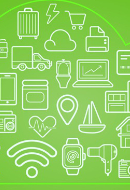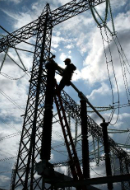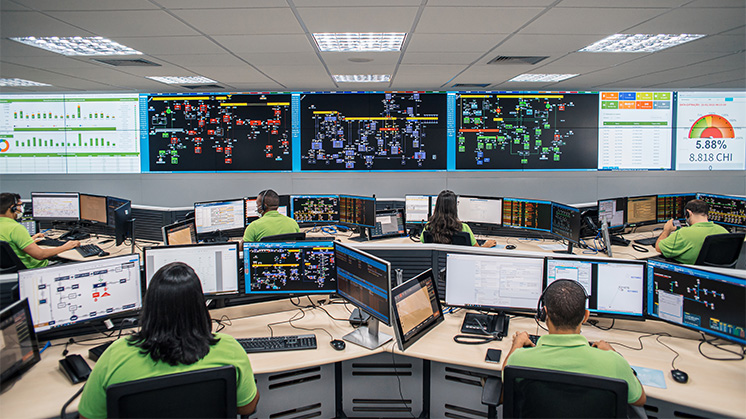Telecommunications for the smart grid
Telecommunications trends and applications in the smart grid
Electrical network Cybersecurity Operating plants
After their spectacular evolution in recent decades, telecommunications have become an essential and indispensable component for the proper operation of the electricity grid. Discover our progress in this field as pioneers in the deployment of telecommunications services for the electricity network.
When mobile phones – let alone smartphones – were not even in our imagination, electricity grids already relied on what were known as “operational voice” calls to communicate at key facilities. This service enabled operators working on the electricity grid to communicate with one another and with the control centre, and it remains fundamental today to ensure the required efficiency and safety.
By the mid-20th century, automation of grid assets began to spread. Specifically, protections were installed (to safeguard assets and, above all, people) along with remote control systems that sent information on the status of facilities to the control centre, and in turn could receive commands to operate the grid. These systems require reliable, specially designed telecommunications links in order to function properly in unexpected situations. Once operations adapt to these means, telecommunications become an inherent element in the deployment of the electricity grid.
Evolution of telecommunications in the smart grid
Today, telecommunications are an essential component for the efficient, safe and reliable operation of the electricity grid. Iberdrola, a pioneer in the deployment of telecommunications services for the grid, continues to lead their development in every necessary field. This progress can be seen in two main areas:
- Digitalisation: The evolution of information technologies has enhanced conventional operations, transforming the way we work. This makes it possible to increase the effectiveness and efficiency of operations, allowing our customers to benefit directly.
- Use of dedicated networks: Iberdrola deploys its own telecommunications networks, providing services adapted to the specific requirements of grid operations and their customers. As a result, energy distribution is carried out more efficiently and above all more reliably, while also reducing operating costs.

Distribution system operators (DSO)
How can network management be transformed into a smarter model?

Internet of Energy
The future of energy efficiency: the internet of energy.

Internet of Things (IoT)
Are we ready for the world that new technologies will bring?

Electrical substations
Find out what electrical substations are and how they work.

The road to smart grids
A global transition to a green grid powered by renewables.
Types of telecommunications applications in the electricity grid
This evolution in telecommunications is transforming the way the electricity grid is being developed and operated, in pursuit of greater efficiency. This can be mainly found in the following three areas:
Iberdrola at the forefront of smart grid telecommunications
Iberdrola’s leadership in telecommunications linked to electricity networks has made us a global benchmark in this field. Some examples of cutting-edge technologies we use include:
- Optical fibre transmission using DWDM (Dense Wavelength Division Multiplexing): this technology makes it possible to transmit up to 100 times more information through a single optical fibre by using “light in different colours”. Each “colour” carries the same amount of information as a single conventional fibre.
- High-capacity IP/MPLS (Internet Protocol / Multiprotocol Label Switching) digital networks: enabling the transfer of large volumes of information, using the same technology that underpins today’s internet backbone.
- Use of 4G and 5G networks, both through commercial operators’ infrastructure and through our own dedicated networks.
- PLC (Power Line Communications): telecommunications over power lines. We are leading the development of the PRIME (PoweRline Intelligent Metering Evolution) standard, which enables large-scale telecommunications to support the millions of smart meters installed to serve our customers, without the need for additional infrastructure beyond the power cables. We also have tens of thousands of devices deployed with broadband PLC (BPL) technology, which allows network assets to communicate through medium-voltage underground cables. This technology also improves the operation of the low-voltage grid.
- Software Defined Networks (SDN): we are leading the implementation of this technology in operational environments to enhance the resilience of automation and control of our electricity grid.
Innovative telecommunications serving Iberdrola’s electricity grid
At Iberdrola we continue to make progress in telecommunications, leading multiple innovation projects in all the countries where we operate to develop technologies tailored to the needs of an electricity distribution company. These technologies enable, among other things, greater automation and control of the grid, advanced smart metering functions, communication and information support for field crews and improved communication with customers.
It is worth noting that the development of smart grids has required the deployment of extensive telecommunications networks by electricity companies. These networks have expanded from serving a few thousand sites to having millions of points of presence, with services that go far beyond the traditional ones. This has been a challenge to which the company has responded with innovative solutions.
Iberdrola has been a pioneer in this field and will continue to innovate through the development of projects to improve the performance of its telecommunications networks. This has established the Group as a global benchmark in the sector, always with the aim of improving the service we provide to our customers.









